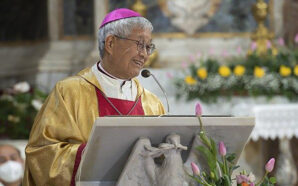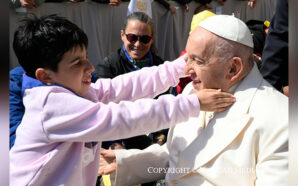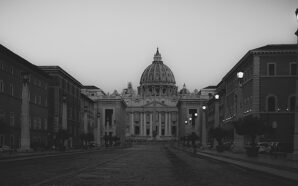Homily for the Fifth Sunday of Lent Year A 2020
Readings: Ezek 37:12-14; Romans 8:8-11; John 11:1-45
29 March 2020
‘Unbind him. Let him go free.’ With these words, Jesus brings new life to Lazarus. All around the world today, there are health care workers and loved ones looking at ICU beds dreaming and hoping that the one in the bed might be unplugged and walk free from the effects of the all pervasive coronavirus.
Jesus loved Lazarus. Jesus wept when Martha and Mary, the sisters of Lazarus, confronted Jesus with the message, ‘Our brother would not have died if you were here’. All around the world today, there are families crying out, ‘Our loved one would not have died if only others had heeded the warnings on physical distancing and self isolation.’
LISTEN: https://soundcloud.com/frank-brennan-6/homily-29320
Jesus had fled to the Transjordan region to the east of the River Jordan after the Jews had picked up stones and chased him from the temple and then later wanted to arrest him, he having managed to elude them. On hearing news of Lazarus’ illness, Jesus was minded to return to Judaea and the prospect of his own death. He wanted to do the natural, loving thing for his friends Martha and Mary. He also wanted to do the extraordinary thing and bring life to Lazarus who would be dead by the time Jesus arrived. Jesus was putting his own life on the line for his friends Lazarus, Martha and Mary. As Thomas said to the other disciples, ‘Let us go too, and die with him.’ All around the world today, there are health workers putting themselves on the front line risking all, so that others might have life, and live it once again to the full when the age of the virus passes, as it eventually will.
When Jesus reaches Bethany near Jerusalem he is greeted first by Martha and then by Mary. Mary is the one who a week later, just six days before the Passover, will come to Jesus and anoint his feet with costly ointment, then wiping his feet with her hair. Judas will be shocked, thinking about the savings that could be made by selling the ointment. Jesus will say, ‘Leave her alone; let her keep it for the day of my burial.’
The writer of the gospel wants us to draw a close parallel between the death of Lazarus and the death of Jesus, and between the raising of Lazarus by Jesus and the resurrection of Jesus. Jesus tells people to take away the stone from the tomb of Lazarus. When Mary of Magdala, Peter and the other disciple reach the tomb of Jesus, the stone has already been rolled away. When Lazarus emerges from the tomb, there is a cloth around his face. When the disciples enter Jesus’ tomb, they find that the cloth which had been around his face already rolled up and placed by itself.
Jesus is the one who gives new life to Lazarus, ordering that the stone be removed and that the cloths be unbound. Jesus is the new life whose stone does not need to be removed and whose cloths do not need to be unbound. As Martha declares, ‘Yes Lord, I believe that you are the Christ, the Son of God, the one who was to come into this world.’ The writer of this gospel concludes with a statement of purpose. The book is written ‘so that you may believe that Jesus is the Christ, the Son of God, and that believing this you may have life through his name.’
The scripture scholar Brendan Byrne SJ says, ‘The reality of death is both the supreme challenge to faith and the greatest spur for its exercise.’ Everyone of us will experience the challenge and the spur, and both of those in spades in the coming weeks and months.
Like Jesus, Mary and Martha we have our friendships which will sustain us in these times. Like Martha and Mary, we will encounter Jesus on two levels in the days ahead. We will encounter him in the love and service of those around us – in the ordinary human acts of love and forgiveness. In our selfless loving neighbours we will see the face of Christ. We will also encounter him as the face of God with us – the one who has gone ahead of us through suffering and death, the one who conquers the world and is one with the Father. After the raising of Lazarus, Jesus enters Jerusalem, washes the disciples’ feet, and speaks to them of the coming of the Paraclete when he dies and goes to the Father. He asks, ‘Do you believe at last?’ He tells them, as he now tells us:
‘Listen: A time is coming and in fact has come when you will be scattered, each to your own home. You will leave me all alone. Yet I am not alone, for my Father is with me. I have told you these things, so that in me you may have peace. In this world you will have trouble. But take heart! I have overcome the world.’
Like Martha and Mary we will console each other in times of loss. Our faith will not spare us the effects of the virus, including death for some and financial destitution for many others, and for a long time to come. But our faith will sustain us and strengthen us as we take on the burdens of this pandemic. We will draw hope: not only because the world’s scientists are united in purpose to find a vaccine; and not just because people of good will across all nations, races and classes will be united in our common humanity confronting our mortality and fragility. For decades of plenty and economic growth, we humans have become godlike – thinking we can roll away the stone unaided, and able to remove the face cloth without assistance. We Christians will draw hope because we believe even in the midst of pestilence that Jesus has conquered the world and united us with the Father. Jesus gives our lives meaning and purpose even in the vortex of a pandemic spreading death and wreaking global economic destruction.
Like Martha and Mary, we need to attend to the ordinary routines of life and to the familiar relationships in our lives. We also need to remember deeply the lessons to be learnt from this pending test of our humanity. And remembering, we need to be able to celebrate the ordinary things and rituals of life. It’s in doing all three things – the daily chores, the remembering, and the celebrating that we will collectively hear the invitation and do as invited, ‘Unbind them, let them go free.’
It may be the Irish in me, I being a Brennan and my mother an O’Hara, but I have found inspiration these days in the way the Irish remember the Irish famine of 1845-9, the way they celebrate their Irishness wherever they be on St Patricks Day, and the way they extend the ordinary courtesies to their neighbour with a glint in the eye and a lilt on the tongue. The Irish poet Seamus Heaney wrote many poems about potatoes. In the poem ‘At a Potato Digging’, Heaney describes the labourers behind a mechanical digger harvesting the potatoes from the soil. ‘Centuries/Of fear and homage to the famine god/Toughen the muscles behind their humbled knees,/Make a seasonal altar of the sod.’
Remembering deeply the lessons of the 1845 famine, he writes:
‘Hope rotted like a marrow.
Stinking potatoes fouled the land,
pits turned pus in filthy mounds:
and where potato diggers are
you still smell the running sore.’
But there is hope. The ordinary things of life can be celebrated – not denying the suffering and death, but living through the suffering and death:
‘Under a white flotilla of gulls
The rhythm deadens, the workers stop.
White bread and tea in bright canfuls
Are served for lunch. Dead-beat, they flop
Down in the ditch and take their fill,
Thankfully breaking timeless fasts;
Then, stretched on the faithless ground, spill
Libations of cold tea, scatter crusts.’
Let’s help to unbind each other, and let us go free. Let’s give thanks that, like Martha and Mary, we can even share the simple things like the white bread and tea on ground which is not faithless, but faith-filled. Let’s roll away the stone.
Fr Frank Brennan SJ is the Rector of Newman College, Melbourne and the former CEO of Catholic Social Services Australia (CSSA).








